A scrum master assumes a project that is essential to organizational growth. The project is expected to be in production for three years. What should the scrum master do first?
During the high-level estimation for a project, the team contacted the product owner about the client’s requirements. The team is seeking guidance as their estimate is too big and there is a risk of not finishing the project in time.
What should the product owner do to help the team?
A new project starts and team members are pooled together to execute it. The team works together and moves from the forming stage into the storming stage. However, potentially destructive conflicts are now arising.
What should the agile coach do to develop members into a high-performance team?
A key stakeholder cannot attend the project vision statement development workshop. The stakeholder has emailed their requirements to the agile team lead, and believes that the vision statement is not critical.
How should the agile team lead respond?
A diverse team can sometimes create misunderstandings and conflict, leading team members to isolate. How can an agile project manager promote effective communication and collaboration among team members with diverse backgrounds and perspectives?
A company is planning to launch a new service to improve the customer checkout experience. What should the project manager do to meet the objective of reducing time to market to gain a competitive advantage in the industry?
A team member has spent 5 days on a spike and the first set of experiments has not been successful. The issue is the development team member has determined a short-term rather than a long-term solution.
What should the project leader do?
Midway through a two-week sprint, an agile team realizes that the features cannot be delivered within the sprint. The team determines that another week will be required to complete all committed features.
What should the team do?
There is a debate within the organization on whether projects need to be agile or waterfall. Some agile terms and principles are understood differently by the key stakeholders and this delays the decision-making process.
How should the scrum master proceed?
A member of the development team displays disrespectful behavior and continuously argues with colleagues. This is negatively impacting team morale.
Which action should the scrum master take to resolve this situation?
How can an agile project manager ensure that all stakeholders have a clear understanding of the release plan by the end of a release planning meeting? (Choose two.)
An agile coach is assigned to help a project team that was recently co-located close to a very popular business Many team members visit this business during working hours which affects team performance.
What should the agile coach do to mitigate this issue?
A scrum master is observing the daily coordination meeting of an agile development team. The scrum master realizes that one of the developers is confused about a business rule for the solution they are building.
How should the scrum master address this issue?
When working on a new product, what should an agile team do to ensure alignment with external stakeholders?
During refinement, the team tester has a question about part of the acceptance criteria for a given user story. Who should clarify the acceptance criteria?
A key resource is switching between projects to obtain more visibility and acclaim. However, project work has grown and become a burden.
What should the agile project leader do?
An agile team identifies that their velocity is lower than predicted, and that their previous forecasts in the product roadmap are wrong. The team is worried that they will be unable to meet a critical release date without corrective action.
What should the team do?
An agile lead has been assigned to a project to develop an innovative digital device for a consumer products company. The company asked the agile lead to use a Scrum approach to product development. The product owner has worked on Scrum projects before and is excited about the value Scrum will bring to the company.
What should the scrum master do first?
During mid-sprint changes, an agile facilitator meets with the executive and development teams. During the meeting, executive team members resolve conflicts, and on their own initiative, review the iteration charts to discuss changes to the iteration's functional goal.
What practice is the agile facilitator implementing?
A project team has a senior subject matter expert (SME) who is comfortable with data integration. The SME is not inclined to perform regression testing because the SME feels that performing regression testing is more of a junior duty.
What should the scrum master do?
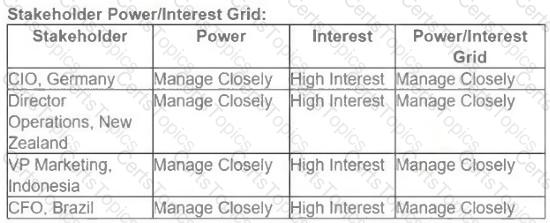
An agile development team is working on a digital transformation project and is facing challenges in obtaining consistent feedback from stakeholders who are dispersed around the world. The product owner is under pressure as this lack of engagement has led to prolonged decision-making cycles and has adversely affected the outcomes of sprints.
How should the team improve stakeholder engagement to help ensure timely feedback and better decision-making? (Refer to Stakeholder Power/Interest Grid)
New stakeholders are joining a project team where the agile coach will educate them about their roles and responsibilities. How should the stakeholders ensure their objectives are met by product delivery?
An agile lead is experienced with predictive and agile approaches. The agile lead was recently invited by human resources (HR) to be part of a learning team. During roundtable discussions with the project management team, the agile lead states: "I foster a safe environment for disagreement so my team feels empowered to move forward without obstacles."
What is the agile lead attempting to highlight?
At the retrospective, the burndown chart shows that the project is slightly behind schedule. The project team identifies an inexperienced software engineer as the source of reduced velocity. How should the project team address this issue?
A new project is under way and the team is using the Kanban method. One of the team members raised a specific issue related to a programming language that the team member faced in previous projects.
What should the project leader do to handle the issue?
During a backlog refinement meeting, a senior team member raises a concern about an epic sizing that requires the use of a new interface for a vendor product. The product owner acknowledges this as a risk. What should the product owner do now?
An executive sponsor asks a team when a specific feature will be ready for release. A team member states the feature will be ready by the end of release 3 because it is not a core feature. The team member directs the sponsor to an information radiator, where the sponsor sees several notes grouped by release numbers and posted on the wall.
What is the sponsor looking at?
A project's first iteration contains item A and its second iteration contains item B The first iteration is behind schedule, which will impact the second iteration. Since items A and B are similar, a team member suggests beginning the design of item B.
What should the agile practitioner do?
Business stakeholders of an agile project frequently skip the review meetings. What should the agile practitioner do?
An agile team member from a cross-functional team has been unable to complete assignments due to tasks assigned by the functional manager. What should the Scrum Master do?
During iteration planning, it was determined that an epic should be decomposed What was the determining factor?
An agile project leader notices that the team's velocity has decreased in examining data provided by team members, the project leader discovers that one team member has been slow to enter story statuses
What can happen as a result?
An agile team and a traditional development team are working together on a project. Each team exceeds expectations regarding deliverables: however, issues arise when the deliverables are integrated. What should the agile practitioner do?
An agile coach is working with a team that serves clients making product requests by phone. During a daily commitment and replanning meeting, a team member states that they were unable to resolve a client request because they lacked sufficient product knowledge.
What should the agile coach do?
During a daily stand up meeting, a developer expresses concerns that the selected technology limits the number of concurrent users. What should the agile team lead do?
During sprint retrospectives, some team members are very vocal and tend to dominate the conversation, while others are more reserved and less likely to participate. What should the scrum master do?
Project stakeholders are finding it difficult to know the real-time status of who has been assigned to various stories and the status of each work item. Which of the following should the agile project manager do?
A project manager is working on a user story about migrating to a new version of a database but is unsure of the dependencies. What can the product owner request from the team to understand the risks?
A new product owner shares the product vision during the team launch event. The team asks for clarification on the product roadmap and its high-level features.
What should the product owner do?
One of the overseas stakeholders on an agile project has not been actively involved in the project's development. What would be the first step to reengage the stakeholder?
A member of the development team is working on a prioritized non-functional requirement involving integrating with a 3rd party system. This integration has not been done before on the project.
What should the project leader suggest?
The amount of information captured in the project's defects is varying within the development team. Team members are becoming frustrated with the defect quality inconsistencies and the frequent clarification required.
What should be done to address the issue?
A team's technical lead believes that manual testing tasks should be conducted by junior team members below their level. The junior team members think it is unfair and refuse the tasks.
What should the scrum master do?
During a retrospective meeting, a team develops a large list of initiatives All will have a positive impact and improve team performance What should the agile coach do next?
An agile team is struggling with an issue. A team member mentions that another team had a similar issue that was resolved, but lessons learned documents are unavailable.
What should the agile practitioner do?
A project manager is concerned that the team has misaligned expectations with some stakeholders, and that user stories were written only from a generic user's perspective. This may lead the team to miss stories for non-generic users.
What agile tools can help the team address these issues?
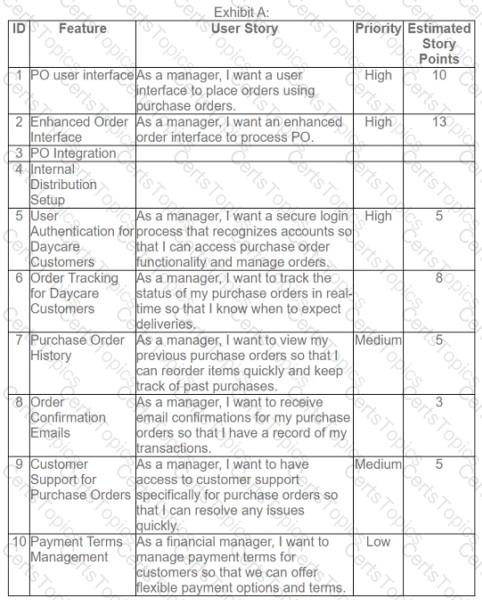
A food company seeks additional business-to-business (B2B) revenues from some customers by
implementing purchase order (PO) functionality. To achieve this, the agile project team is exploring PO integration options (see item #3 in Exhibit A), as the product increment (PI) planning process is underway.
What should the project team do next?
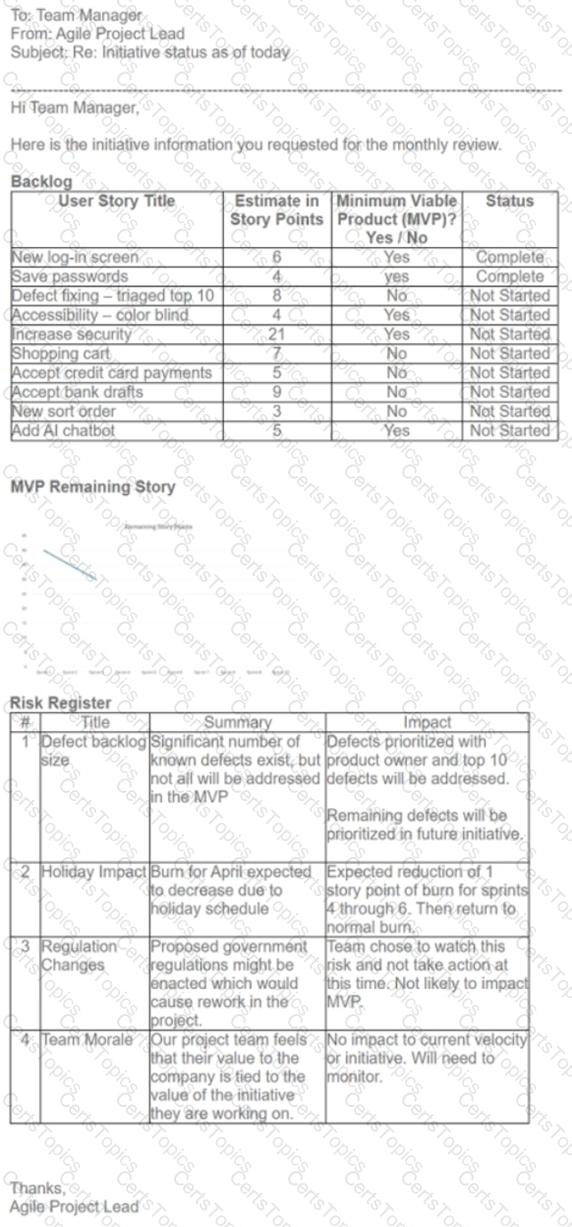
A project team's manager is responsible for delivering a specific initiative for the organization. They are preparing for a monthly meeting where the manager will present on the current state of this initiative. The agile project lead sends the manager the following email with the current initiative status (see Exhibit A).
How many sprints will be needed to complete the entire backlog?
The team is refining user stones during the backlog grooming session and confused on the acceptance criteria and level of details What should the agile practitioner do?
A team developing application software is working in pairs. A project manager notices that important information is sometimes not shared among team members, leading to delays in the development process.
What should the project manager do to improve team performance and eliminate any communication impediments?
A For new pairs of developers based on the years of expertise and project management Knowledge
B. Use task boards so the team can keep track of the work done and future implementation planning.
C. Schedule in-person meetings at the end of each iteration, allowing team members to share knowledge and experience.
D. Seek expert judgment and a new collaboration model that will strengthen team cohesiveness.
A mobile application project is halfway through development. The team reaches a stabilized velocity after 8 iterations. The sprint duration is two weeks and requirements assigned by the product owner are not changing frequently.
What is the estimated time remaining for the project?
During an agile team retrospective, some junior team members discussed an approach that could improve the overall team performance. How should the agile practitioner handle the recommendation?
Two team members are working together to deliver an asset management tool. The code delivered by team member A during this sprint is not aligning with the specifications written by team member B. Both team members do not seem to agree on the look and feel of some functionality.
What should the scrum master do in this situation?
During a current sprint, a team member asks permission from the scrum master to investigate an alternative design approach What should the scrum master do?
One of the main stakeholders of a project is new to Scrum. The stakeholder asks what to expect in the sprint retrospective.
How should the product owner respond?
A project team member expresses frustration about the length of time it takes to make decisions for a complex project. Approvals needs to happen at many levels in the company.
What should the team lead do to improve decision quality and reduce the time required to make decisions?
Unable to meet a sprint's committed velocity, an agile team approaches the agile coach to define the next sprint's velocity. What should the agile coach advise?
During backlog refinement meeting, the new developer on the team asks the product owner to discuss a new performance threshold requirement and how it impacts the stories in the backlog. What should the team do?
During sprints, the development team members are frequently invited to various meetings to provide technical opinions, consuming the team's working time and causing compliance issues. Which action should the scrum master take to address this situation?
During a team meeting members who are subject matter experts (SMEs) mention that they are continuously working on repetitive tasks which has lowered motivation. What should the agile practitioner do?
A team lead reviews processes and identifies bottlenecks that prevent the teams from quickly delivering minimum viable products (MVPs). Which responsibility falls within the context of servant leadership?
During initial planning, a project team investigates several approaches to building new application software, emphasizing the most valuable deliverables. The team needs to convince stakeholders and win their approval.
How can the project team achieve this?
HOTSPOT
Organizations that implement agile project management focus on upgrading existing products and services through cost reductions, time savings, or quality enhancements for existing customers (i.e., operational agility). Organizations need to realize that the major financial gains from agile project management will result from the practice of what? (Select answer from dropdown)
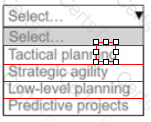
The executive leadership wants to understand ways to better deliver on time and on budget. What can the project team do to assist in achieving the organizational goal?
A scrum master is part of a team that has just agreed on the project scope and deliverables for a global, multilingual manufacturing company that has many staff members moving between locations. The team consists of 20 people and the budget is US$5 million. The kickoff meeting is scheduled for the following month.
What should the scrum master do as a first step?
A project sponsor suggested a team forgo in-person demonstration meetings and just send the product owner a link to try out the latest increment of working software. The sponsor says this will give the team more time to deliver value.
How should the agile coach explain the importance of an in-person demonstration meeting with the sponsor?
A stakeholder complains about the amount of changes that are being introduced to a project. What should the product owner do?
In several recent agile team status meetings, there have been discussions about increases in costly bugs and late product deliveries, resulting in lower quality and higher costs. Team members feel they spend too much time in planning and process meetings, then feel rushed to complete their work.
How should the agile lead implement an effective and efficient solution?
An agile team consisting of eight members is in their 11th iteration of a project. In the last iteration, the team was not able to complete every scope item it had committed to before the demonstration.
Which approach should the agile lead take?
An agile team consisting of eight members is in their 11th iteration of a project. In the last iteration, the team was not able to complete every scope item it had committed to before the demonstration.
Which approach should the agile lead take?
The agile team has failed to meet their iteration goal, and contention has developed between members. The agile leader would like to determine how to improve the team's productivity and morale.
How should the agile leader address this?
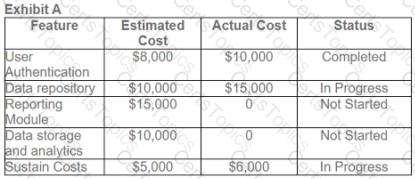
The product owner is working on an application that will be built in a data lake leveraging a data
integration and transformation software application. With a budget of US$17,000 remaining, how should the product owner allocate the money? (Refer to Exhibit A)
An agile team is working on a new product and is behind with their deliverables for the quarterly release. The team discovers new issues during each iteration. They start working on the critical issues and sometimes forget to update the backlog. This leads to confusion, delays, and occasional rework.
How should the agile practitioner improve the team’s productivity?
After a successful product deployment, a key stakeholder informs an agile team member that an implemented feature is failing to deliver its expected business value. The team member replies that the requirement was provided by the customer, and that the scope was clearly met.
If the problem were an issue of requirement elicitation rather than delivery, what should have been done to avoid this situation?
A development team is calculating the number of story points they have completed at the end of an iteration. Although quality assurance (QA) passed and successfully demonstrated one feature, it is not being included in the release package.
Should the team add the feature's story points to their burndown chart?
A large, corporate organization is forced to hire new team members in a geographically remote location from the current team. The manager of the department is concerned about the team not being colocated.
What behavior would indicate the team is not working well together?
An agile team is under pressure to deliver an application. The product owner anticipates many change requests from customers once the product is released.
What should the agile team do?
Stakeholders are unhappy because they have not been consulted on a user interface (UI) for a project that will have a significant impact on end users once it is launched. How should this situation be handled?
Iterations last between a couple of weeks to a couple of months, with a preference for the shorter time. What is the goal for each iteration?
During a Kanban team's daily stand up, an agile coach observes that the team seems disinterested in the work status. While it appears that there are no issues with flow, there is a marked lack of attention to team effort. When the agile coach queries the team for reasons, members explain that work continues to be scheduled with no end in sight.
What should the agile coach do?
A globally distributed project team is using email and phone calls as the only way to share information. Delays in resolving issues often occur due to misinterpreted communications, leading to a lower team velocity.
What steps should the project leader take to improve knowledge sharing?
Midway through a sprint, a team member discovers that the product design fails to adhere to the organization's enterprise architecture standards. Since this required escalation to the architecture team for further analysis and resolution, the team was unable to deliver its sprint goal and the sprint was cancelled.
What should the team have done to avoid this?
An agile team is optimizing the workflow by investing in initiatives to identify and reduce unnecessary handovers and delays. What should the team do in this situation?
An agile team has started to worry because lately they have seen an increase in the number of issues. There seems to be a large variance in the quality of the work items delivered. The team now realizes that a shared understanding of quality may not exist among team members.
What should the team do?
A team working with a new technology faces a significant amount of uncertainty about its ability to deliver stories due to technical issues. What should the team do?
An agile coach has been hired to improve the performance and quality of developed software. The coach performed an analysis of the software and discovered an excessive number of escaped defects, leading to external failures.
How can the agile coach effectively address and correct defects in the software development process while maintaining predictability and keeping workloads within capacity?
In a project, the customer asks for a requirement that clearly deviates from the contract terms. How should the contractor react?
A senior team member feels underutilized. What should the agile practitioner do?
A software development team is working in an environment in which increased competition, demanding customer expectations, and new technological developments pose significant challenges. How should the team plan improvements to their product?
During the project initiation stage, a team has estimated story points for all user stories. When the project team explained the minimum marketable feature (MMF), however, they were not confident that the solution would actually work.
What can the team do to better manage this situation?
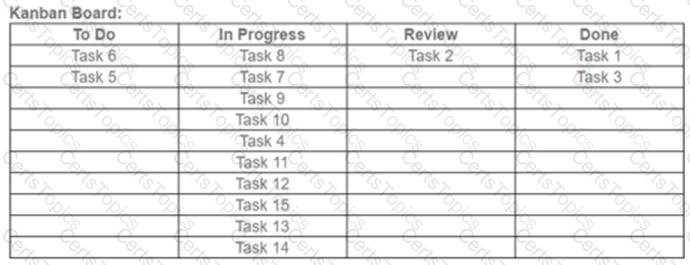
A product owner is working on a special agile project for the automobile industry. The project team is responsible for all of the issues related to vehicle electronic control units. The team hasobserved a significant backlog of items in the “In progress' column (Refer to the kanban board). This accumulation is causing delays in task completion and impacting overall project timelines. The team operates in a dynamic environment where requirements frequently change, and stakeholders demand quick turnarounds.
What should the project team adopt to address this issue and improve task flow, considering all the demands?
An agile team often fails to deliver its sprint goal. At a sprint retrospective, the more experienced team members complain that the less experienced team members are working too slowly. This creates tension in the team.
What should the scrum master do to remove this tension?
A team is delivering work as per the sprint plan, and team velocity is stabilized. However, at the end of the release, the customer is dissatisfied with project quality. What should the agile project manager have done to avoid this?

Based on the backlog metrics in the chart what can explain the jump in points at the end of iteration 4?
A Kanban team is struggling to prioritize and determine which tasks to handle first according to value. What should the team do to improve this situation?
A project team is currently working on sprint seven of a release that is estimated to require twelve sprints to complete. The team has reviewed the stories for this sprint and discovered that it will require rework from previous sprints.
What should the scrum master do?
A project team is currently working on sprint seven of a release that is estimated to require twelve sprints to complete. The team has reviewed the stories for this sprint and discovered that it will require rework from previous sprints.
What should the scrum master do?
During a sprint demo, a business representative identifies missing requirements. The agile practitioner realizes that all key stakeholders were not included during requirements detailing.
What should the agile practitioner have done to avoid the situation?
Several team members have complained to senior management about their scrum master's processes. What should the scrum master do to address the team's process concerns?
An agile team lead is assigned to a project that must ensure data security. What should the team lead do to guarantee that security, as a non-functional requirement, is managed throughout the project?
Several team members are new to agile and there is a lot of confusion. It seems everyone is coming in with different experiences and following their own agendas. The scrum master decided to hold a presentation on core agile principles and values.
What should the scrum master emphasize to the team during the presentation?
A key stakeholder feels they do not understand the project at a comprehensive level. What should the agile practitioner do?
A newly formed team is struggling to work together and agree on how to complete tasks in the upcoming sprint. What should the scrum master do to support the team?
In companies where decision making is driven by data analytics and unknown variables are addressed, what advantages does agile project execution offer over a predictive approach?
At an iteration review, the product owner indicated that the work delivered did not meet expectations. The project team is surprised.
How should this situation have been prevented?
A scrum team is working on an important project with a short deadline. To save time and reduce overhead, the product owner proposes that the regular sprint reviews should be cancelled and replaced with a review of each release according to the release plan.
What should the scrum master do?
An infrastructure team had to revamp so downstream channels could consume data from the data lake, thereby improving operational efficiency for the end customers. Which primary components should the product manager consider while plotting performance and dependencies on the product roadmap?
During a team meeting, conflicting opinions arise regarding the best approach to complete a project task. The project manager wants to ensure that the team can effectively handle these conflicts and come to a resolution that benefits the project.
What is an effective way to handle conflicting opinions in team meetings in an agile environment?
During a team meeting, conflicting opinions arise regarding the best approach to complete a project task. The project manager wants to ensure that the team can effectively handle these conflicts and come to a resolution that benefits the project.
What is an effective way to handle conflicting opinions in team meetings in an agile environment?
During a project's last iteration, an agile team struggled with a feature's delivery due to the lack of a required skill. The project has already incurred a five-day delay. A further delay of at least 10 days is anticipated.
What should the agile project leader have done to avoid this situation?
An organization strives hard to accelerate value delivery by improving product design, development, and transition activities. What ways of working should the organization discontinue to become an effective player?
What is the risk of using agile in a distributed team?
A Frequent integration of work produced
B. Lack of shared knowledge of user stories
C. Need for more locations to learn agile
D. Unclear team structure
A project team has been working on a new application. The application is technically challenging, because the team is using new technology unknown to the development team and business requirements are unclear. The product owner has been working closely with the stakeholders to ensure alignment with requirements and other issues. The agile lead is working with the team and product owner on the product backlog.
What is the role of the team?
A customer has difficulty explaining how the highest priority feature will work. What should the agile project manager do?
What should a team do when they complete all sprint goals earlier than expected?
During agile training, an aspiring scrum master with experience in predictive projects asks about the differences between the Kanban approach and the agile approach.
How should the agile trainer respond?
The product owner is very concerned about work not being completed and tested before a hard release date. What can the agile team do to mitigate this risk?
How should a project leader manage stakeholder expectations in an agile project?
There is a database feature requiring three members of a seven person team. A meeting is scheduled at the beginning of the sprint to go over technical needs to complete the story. Who should the Scrum Master invite to the meeting?
On a complex project with a large degree of uncertainty, the team’s velocity is declining. Upon testing, it is discovered that many of the work items reported as complete are not meeting the stakeholders requirements.
Which of the following could help resolve the incomplete work?
In a planning meeting, the client does not have a clear understanding of the most beneficial features of a project, because there are too many stakeholders with different requirements. How should the project manager approach this project?
Just before a scheduled product launch, the customer declined to accept the final deliverable after seeing the demo. What should the project manager do to prevent this in the future?
A development team, new to scrum, questions the need to collect metrics on team performance. While learn members understand velocity and burn down, they feel that once velocity becomes settled it is needless to keep track.
What should the agile coach tell the team?
A member of a cross-functional project team is not able to attend regular status meetings and provide progress updates, which is impacting the productivity of the entire team. What should the product owner do to improve productivity?
During project inception, an agile practitioner engages the stakeholder to ensure alignment on the project's strategy and vision. The stakeholder asks for detailed requirements, design and delivery plans.
What should the agile practitioner do?
When a team member encounters an issue in an agile environment, what should they do?
Why is stakeholder engagement important for project success?
An agile team is continuously interrupted by stakeholders wanting to ask product backlog questions. Distractions can have a negative impact on value delivery and quality.
Who is responsible for protecting against distractions?
A project sponsor is upset that an enhancement will be unavailable until next year. What should the product owner do?
A product owner concludes that the majority of a project's value can be delivered by completing only the first half of the prioritized backlog. What should the product owner do next?
Early in a project stakeholder analysis is performed: however, an organizational restructure redefines key roles What should the project team do?
A project's product owner asks the scrum master to facilitate the estimation activity. The scrum master then meets with the team and the product owner to clarify the user stories. Following the meeting, the team assembles and provides individual user-story estimates.
What technique did the team use?
A project team is working with an enterprise agile center of excellence (CoE) to transition to a Scaled Agile Framework (SAFe). Many of the team members are not familiar with the new methodology and are worried that it will lead to more work and scrutiny.
What should the agile team lead do to help ensure a smooth transition?
Following approval of a business case, a company will introduce a new mobile app for customers to place orders. Time to market is a key concern. The product has entered into the 3rd iteration, but the team is concerned because they feel the technical designs do not meet the agreed-on definition of done (DoD). An agile coach has been hired to help validate product delivery against business requirements.
What should the agile coach do?
During a retrospective, team members suggest process improvement ideas. The agile team lead knows that, while many of these ideas are different from standard practices, a few of them are good. What should the agile team lead do?
A product owner wants to create a release plan given the team is working in a chaotic environment. They want to set expectations about what is likely to be developed and in what timeframe for some of the stakeholders.
What should the product owner include in the release plan to achieve this?
Two agile teams from different company sites need to work and collaborate on the same project. What is the first action the agile project manager should take in order to ensure a smooth collaboration between the two teams?
A team is preparing to demonstrate new product capabilities to a leadership team. The demonstration will show working software and a listing of the projected value of the capabilities.
What should the team do to ensure the demonstration is successful?
A graphic designer on an agile team does not attend most meetings. When asked the reason for not attending, the designer told the agile practitioner that the scrum master could represent them in meetings if needed. The team is frustrated and does not agree with this approach.
Which conflict resolution method would work best in this scenario?
A team member has asked a question about the responsibilities of the product manager, QA, and the team regarding quality. What should the agile project manager advise?
The agile coach of a development team uses a servant leadership approach. The team is starting the third iteration of an upgrade to a software product, and work is going slower than initially planned.
What should the coach do to help the team?
When introducing agile processes to a company, a quality assurance (QA) manager resists and believes that the switch to agile will remove quality controls and documents How should the agile practitioner address this concern?
Management decides to set up a new project to exploit an emergent market opportunity. Management suggests using an agile approach that is currently working for another project.
What should the agile leader do next?
Management decides to set up a new project to exploit an emergent market opportunity. Management suggests using an agile approach that is currently working for another project.
What should the agile leader do next?
A project manager was assigned to lead the development of a new application for a company. The application will be widely used by all company employees around the world. During the firstmeeting with key project stakeholders, the project manager was asked to find a way to determinate all possible types of users who may interact with the application that is going to be developed.
What should the project manager do next?
During a retrospective, the team agrees that they have limited competence in using a newly introduced tool. What should the team do?
A Scrum Master would like to provide information to key stakeholders on the daily resource and project activities. Which tool should the Scrum Master use to provide these updates?
Agile team A struggles to deliver committed stories due to technical dependencies with team B. which continuously fails to meet its delivery commitments. What should the agile team lead do?